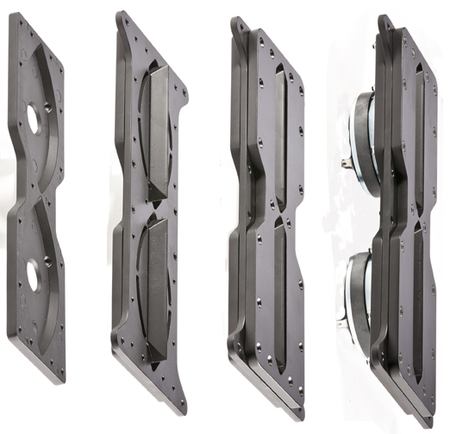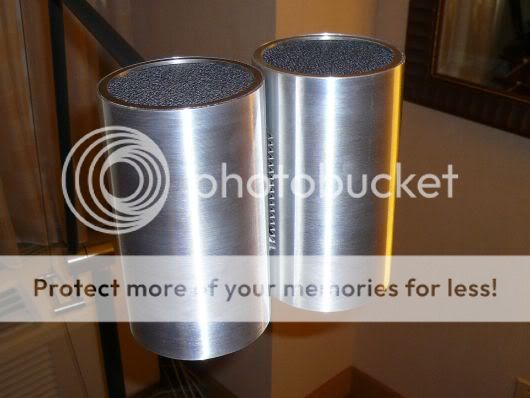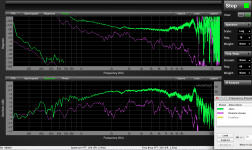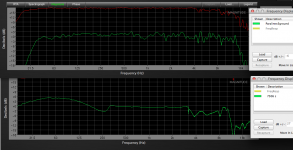Nice one. You are smarter than the average bear.
One of my concerns about the Danley design, and any design that puts LF drivers, or MF drivers in with compression "tweeters" is the pressure in the horn impinging upon the diaphragm of the HF driver. Danley explained this in another post by saying that the ratio of energies going from the diaphragm out was so high that coming back in there would be very little energy for IMD.
With a ribbon in the same hole, I wonder if it is going to still work.
My idea would be to test this is to run the Danley style horn with the HF off, the rest on, and use the diaphragm of the HF section as a microphone to see what is or is not being sent back. Alternately place a microphone set to a suitable FFT analyzer in the position of the HF section...
Hey, I'm a philosopher, not a physicist, but I'm sure Earl or somebody else with the right qualifications will put me straight if I'm off the map.
My thinking is that the mechanical impedance at the end of the duct opening to waveguide (phase plug) will vary with the motion of the driver and so at that point sound at wavelengths of interest is radiated because dimensions there are large enough to allow it.
I'm sure if I've messed it up someone will show me the right direction.😎
My thinking is that the mechanical impedance at the end of the duct opening to waveguide (phase plug) will vary with the motion of the driver and so at that point sound at wavelengths of interest is radiated because dimensions there are large enough to allow it.
I'm sure if I've messed it up someone will show me the right direction.😎
Interesting, I did not know that.
So you're saying that the air in the phase plug moves faster than the speed of sound?
If that is the case, then it helps explain one of the mysteries of the Danley Paraline.

The Danley Paraline is basically a bizarre looking phase plug. And the boxes that use the Paraline use digital delay. This only makes sense, because of the long pathlength. But one of the bizarre things about the Paraline is that the *highs* are delayed, not the lows. They're delayed by 10 centimeters (0.314ms).
And I'd always scratched my head on why this is, considering the pathlength for the highs is longer than the pathlength for the lows.
Interesting.
Interesting discussion...
Ratcheting back a few, Art, the curves shown do not necessarily mean that there is no interference from the low section to the high, IF those are sine swept curves. And also the SPL level counts too...
In the Peavey it looks like the LF section is not *loaded* into the horn section as the mid section is *loaded* into the horn... that too is somewhat different.
But if indeed there is no IMD from the LF modulating the HF, that's quite a thing.
_-_-
Danley's Paraline is quite a trick!
I do like it.
I keep looking at it, and looking at it.
Keep thinking about why there aren't significant standing waves/comb filtering there...
Ratcheting back a few, Art, the curves shown do not necessarily mean that there is no interference from the low section to the high, IF those are sine swept curves. And also the SPL level counts too...
In the Peavey it looks like the LF section is not *loaded* into the horn section as the mid section is *loaded* into the horn... that too is somewhat different.
But if indeed there is no IMD from the LF modulating the HF, that's quite a thing.
_-_-
Danley's Paraline is quite a trick!
I do like it.
I keep looking at it, and looking at it.
Keep thinking about why there aren't significant standing waves/comb filtering there...
I'm sorry, I didn't answer your question.So you're saying that the air in the phase plug moves faster than the speed of sound?
I'm saying pressure change caused by the diaphragm movement is reflected almost instantaneously by a change in pressure at the openings of the phase plug where it enters the waveguide.
I'm not saying the air in the phase plug moves faster than speed of sound sound.
Think of the air from diaphragm to phase plug exit as a single structure
Those phase plug exits are the sound radiators, not the CD diaphragm.
diaphragm =>pressure changes[small dimensions]=>phase plug=> sound waves[big dimensions]
Last edited:
Those tweeters are being made again, in a larger, much more expensive version out of Nashville. They sound very good.
My thinking is that the mechanical impedance at the end of the duct opening to waveguide (phase plug) will vary with the motion of the driver and so at that point sound at wavelengths of interest is radiated because dimensions there are large enough to allow it.
Frank - I'm just not sure that I understand what it is that you are saying. But the impedance varying with the motion of the driver doesn't sound right. Impedance cannot vary in time since it is a concept that only exists in the frequency domain. It can vary with frequency and with SPL, but not with time.
Frank - I'm just not sure that I understand what it is that you are saying. But the impedance varying with the motion of the driver doesn't sound right. Impedance cannot vary in time since it is a concept that only exists in the frequency domain. It can vary with frequency and with SPL, but not with time.
Thanks. Yeah, I think I was having a brainfart. It's a lot clearer after a night's sleep.
I love the hands on stuff here.
I wonder how a fountek cd3.5H with the 'horn/guide' removed would operate in one of the Biradial methods shown here?
🙄
I wonder how a fountek cd3.5H with the 'horn/guide' removed would operate in one of the Biradial methods shown here?
🙄
Bear,But if indeed there is no IMD from the LF modulating the HF, that's quite a thing.
Danley's Paraline is quite a trick!
Keep thinking about why there aren't significant standing waves/comb filtering there...
"No IMD" would probably be impossible, but there is probably no more IMD resulting from the HF and MF sharing a horn than the IMD from a dome tweeter in similar proximity to mids and woofers.
SPL levels in a horn are higher than front loaded drivers, but the additional horn gain would also keep any IMD% similar.
At any rate, regular HD from compression drivers or ribbons at the levels where distortion becomes audible would exceed the IMD to the point where it is a non-issue.
The Paraline does result in more comb filtering than a driver on a conical or OS horn, but probably no more than any of the other devices designed for narrow (or no) vertical dispersion of high frequencies.
The comb filtering has such small frequency intervals that it is not distracting, to my ears my PA using Paralines sounds as smooth as the headphones I use, even though the headphones measure much smoother.
The Paraline advantages outweigh the disadvantages for the intended use.
Art
Art
Comb filtering is different than standing waves, right? Wouldn't it be standing waves in the paraline? Standing waves "should" be audible even if comb filtering is not. Standing waves in horns are clearly audible.
You compare your "PA" to headphones and claim that they sound "as smooth". Why is it then that every PA system that I hear is so bad? Not only not comparable to a decent pair of headphones, but just plain bad. Can it really be that you do or have something that no one else does? I am just trying to reconcile your experiences with mine and sometimes that can be pretty hard to do 😉
Comb filtering is different than standing waves, right? Wouldn't it be standing waves in the paraline? Standing waves "should" be audible even if comb filtering is not. Standing waves in horns are clearly audible.
You compare your "PA" to headphones and claim that they sound "as smooth". Why is it then that every PA system that I hear is so bad? Not only not comparable to a decent pair of headphones, but just plain bad. Can it really be that you do or have something that no one else does? I am just trying to reconcile your experiences with mine and sometimes that can be pretty hard to do 😉
Earl,
Your PA sounds great to you. Other exceptions must exist too.
Any system with a compression driver in it is a PA system. Any other description is marketing hype.
Your PA sounds great to you. Other exceptions must exist too.
Any system with a compression driver in it is a PA system. Any other description is marketing hype.
You compare your "PA" to headphones and claim that they sound "as smooth". Why is it then that every PA system that I hear is so bad? Not only not comparable to a decent pair of headphones, but just plain bad. Can it really be that you do or have something that no one else does? I am just trying to reconcile your experiences with mine and sometimes that can be pretty hard to do 😉
You gotta go down to Guitar Center and hear some of the QSC speakers.
They're a shameless ripoff of your ideas, but they sound great!
The Paraline shows some comb filtering in the response, not sure whether "standing waves" could develop in the 1/4" wide slot used in mine.Art
Comb filtering is different than standing waves, right? Wouldn't it be standing waves in the paraline? Standing waves "should" be audible even if comb filtering is not. Standing waves in horns are clearly audible.
You compare your "PA" to headphones and claim that they sound "as smooth". Why is it then that every PA system that I hear is so bad? Not only not comparable to a decent pair of headphones, but just plain bad. Can it really be that you do or have something that no one else does? I am just trying to reconcile your experiences with mine and sometimes that can be pretty hard to do 😉
Comparison below of EV DH1AMT driver on a Paraline and a narrow conical horn for your perusal.
I equalize my PA to sound like my headphones, many sound people don't.
There are many bizarre ways some "engineers" set system EQ, often applying a global "loudness contour" instead of fixing problems at the individual sources.
I walk around during a show and make sure what I am hearing at the mix location is representative of most seats, a surprising amount of sound people don't ever bother.
The Paraline line array I built (when set up properly) sounds consistent from left to right, and front to back, many systems simply are not capable of that, and many more are badly deployed, screwing up what could be decent.
Line arrays are now used for most touring sound, properly deployed they can be great (or so-so) but seemingly small changes can make a profound (more than 10 dB) variation in level and frequency response.
Then there is stage volume to contend with, when any instrument is too loud to start with, the house sound is compromised- either everything else has to be raised above that level for balance, or the too loud instruments drown out everything else.
Finally, "garbage in, garbage out", if you were to listen to the mixing console's headphone output on a show you found sounded poor, you often would find it sounds nearly as bad as what you hear in your seat.
Kick drum as lead instrument, the mixer knows the vocals by heart so does not notice they can't be heard, the snare drum is not loud enough if everybody's eyes don't blink to the beat, etc.
Now days I am a relatively "small time operator", most of the shows I provide for are for audiences of 1000 or less, and I usually mix the sound myself, but when I was providing "sound by the pound", the opposite was true.
I got to hear mixes by top engineers (many still working with top bands 30 years later), hacks, and everything in between.
If I were to try to put a subjective rating on the thousands of shows with hundreds of engineers, I'd say 20% are equal or better than me, 40% are passable, if you like the music😉 and another 40% are beyond hope- after a few unheeded suggestions to them I put in my ear plugs and look forward to load out.
At least I (almost) always got paid to suffer, I would be pissed had I paid for the bad sound experiences.
Art
Attachments
Last edited:
At least I (almost) always got paid to suffer, I would be pissed had I paid for the bad sound experiences.
Art
That's why I so seldom go to concerts anymore. Although last weekend I saw Sarah Brightman and Diana Krall (different shows). Brightman was in the top 20%, but still pretty bad (especially before the intermission), Krall was in the top 5%. But still neither even came close to a good home system (home PA that is 🙄).
And those curves that you show 😱 You can't fix problems like that with EQ. Those paralines are some seriously bad responses.
I just hope that you guys are really being objective here because everything that I am reading just sounds "too good to be true", entirely non quantitative (except for that last set of curves, thanks for that) and completely different than my experiences. I would expect those paralines to sound exactly like what I hear when I go to shows.
That's why I so seldom go to concerts anymore. Although last weekend I saw Sarah Brightman and Diana Krall (different shows). Brightman was in the top 20%, but still pretty bad (especially before the intermission), Krall was in the top 5%. But still neither even came close to a good home system (home PA that is 🙄).
And those curves that you show 😱 You can't fix problems like that with EQ. Those paralines are some seriously bad responses.
I just hope that you guys are really being objective here because everything that I am reading just sounds "too good to be true", entirely non quantitative (except for that last set of curves, thanks for that) and completely different than my experiences. I would expect those paralines to sound exactly like what I hear when I go to shows.
My 'hunch' on the Paralines, and radial horns in general is this:
I think there may be some type of auditory masking going on here. It's well known that this happens in the frequency domain, but does it also happen in the time domain?
If you look at the CSD of a Paraline, it has a really long tail. (IE, it doesn't 'fade to black' in a millisecond or two.
But the thing that's interesting is that there aren't any obvious ridges in the CSD, or at least there weren't in the measurements that I did.
So I'm wondering if this long decay is masking the higher order modes.
Earl,That's why I so seldom go to concerts anymore. Brightman was in the top 20%, but still pretty bad (especially before the intermission), Krall was in the top 5%. But still neither even came close to a good home system (home PA that is 🙄).
And those curves that you show 😱 You can't fix problems like that with EQ. Those paralines are some seriously bad responses.
I would expect those paralines to sound exactly like what I hear when I go to shows.
At home, we get to listen to recordings that have been performed in controlled acoustic environments using microphones that can be very nuanced and sensitive.
We listen in a "sweet spot", coverage does not have to be even for tens of meters.
Live, every microphone is picking up what it is pointed at (vocal or instrument) as well as level from the stage monitors nearly as loud as the source, and off axis radiation of the mains sound system. The microphones have to be cardioid to increase the direct to reverberant ratio, and cardioid microphones are not smooth off axis.
At any rate, headphones (can be) smoother than the systems we use, but having used a number of my own and dozens of other systems, I can objectively say that with the Paraline system I have now, I can more accurately convey what the mix is to a larger percentage of the audience than anything else I have mixed on.
The relative ragged response of a system pales when compared to the damage room reflections and off axis microphone response all contribute.
Here is a Sony 7506 headphone and the equalized response of five Paraline cabinets with a Keystone tapped horn below.
Of note, had I placed a mic in an ear to measure the headphone response, it would not look near as flat as it does.
Art
Attachments
Last edited:
Art, I just have to say... thanks! I have never seen anyone provide so much real data on this or any other forum. It really helps to see the actual data and then draw your own conclusions.
Nor would the speakers... I'm not a headphone guy, but I have been told that the Audeze models are just about the closest available to the current thinking on the response you want in on-ear headphones for equivalence to a normal sound source. So, here's a graph for no particular reason (measured on a headphone rig):Of note, had I placed a mic in an ear to measure the headphone response, it would not look near as flat as it does.
An externally hosted image should be here but it was not working when we last tested it.
In the first post of this thread I noted that diffraction appeared to change the directivity of a horn or waveguide. This was a surprise to me, as I'd thought that diffraction treatment was mostly 'icing on the cake', basically something you'd add to a waveguide to make it sound a little more listenable and smoother.
But the wavefront simulator in Hornresp seemed to indicate that diffraction could screw up the directivity of waveguide.
In order to explore this further, I have simulated three different cases:
1) a 90 degree waveguide with no mouth termination whatsoever
2) a 90 degree waveguide that transitions to 180 degrees at the mouth. This is similar to what QSC does in their well regarded 90 degree waveguide.
3) a 90 degree waveguide that transitions to 180 degrees at the mouth, then rounds over all the way to the edge, and *also* has a roundover at the *rear* of the enclosure.
Here's the sims:

Here's some observations about the sims:
The first thing I notice is that the roundover seems to send more energy off axis. For instance, if you look at the second and third case you'll notice that there's more energy radiating *behind* the speaker then in the first case.
For me, the most interesting thing about the sims is that the roundover seems to make the energy level more consistent from left to right. If you look at the first row and then compare it to the third row, you'll notice that a greater percentage of energy is focused into the 90 degree 'cone' in front of the speaker. Whether you think this is a good thing is obviously subjective; some will want the loudspeaker to only project into a narrow angle. But I personally prefer that a waveguide makes the response consistent from left to right. And the roundover seems to facilitate that. (If the simulations are accurate, of course.)
Here's some details on the waveguides:
1) Each waveguide is 36cm wide. This is the same width as the QSC waveguide mentioned elsewhere in the thread.
2) I've only varied the *shape* of the waveguide with the roundover. I did not vary the width. Since I fixed the width, the depth of the waveguides vary. (The unterminated waveguide is the deepest.)
Yesterday I noticed that the LeCleach curve and the spherical horn curve are basically a circle. And that the JBL wavguides are similar in shape, but elliptical instead of circular.
So I was curious to see what wave shape would be produced if you took that all the way around the cabinet. This yields a few possible shapes:
1) A figure eight shape
2) The same figure eight shape, but 'squashed' to form an ellipse, like the JBL horns
3) A figure eight shape that's open to the back, which forms a bipole

Here's what the wavefronts look like. Horn 3 is at the bottom, 2 is in the middle, 1 is at the top. Some observations:
1) The figure eight shaped horn has really well behaved wavefronts. Nice and spherical with no weird discontinuities. The conical and OS curves appear to flatten the wavefronts to a degree, but not 100%. So the conical and OS curves seem to produce elliptical wavefronts.
2) The beamwidth of the figure eight horn is quite wide.
3) The elliptical horn seems to work about as well as the figure eight horn. Downside to the elliptical shape appears to be that the beamwidth narrows as the waves get larger than the horn. Note that the 500hz waves are basically cardioid, and have narrowed a great deal when compared to 1khz.
4) Turning the figure eight horn into a bipole seems to work quite well too, and basically makes the horn omnidirectional. I'm not real keen on omnidirectional speakers, but if someone was, the bipole figure eight horn might be worth a look.
Here's some ideas on how you could build these horns out of PVC pipe:


A monopole figure eight might look something like this, minus the conical part at the center.
If you wanted to extend the curve to a full figure eight you could.
This could be built with a miter saw in about an hour.

If you fed the horn with a ribbon it would look like this

A torus would work too, but it's a bit difficult to build.

An externally hosted image should be here but it was not working when we last tested it.
That horn shape looks familiar...
- Status
- Not open for further replies.
- Home
- Loudspeakers
- Multi-Way
- Are Most Horns Fundamentally Flawed?

